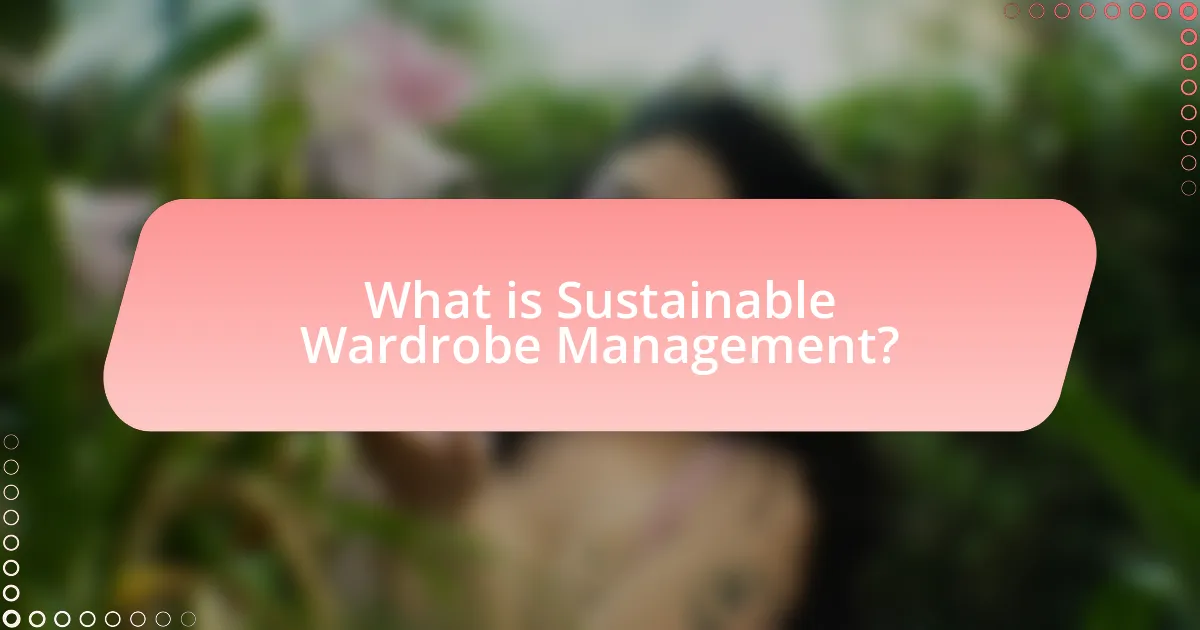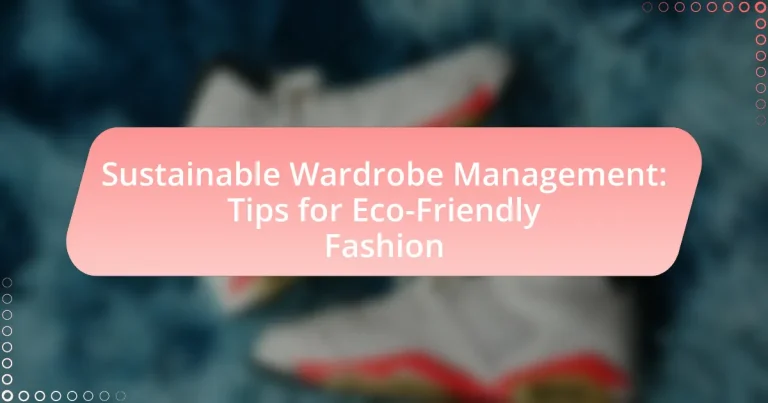Sustainable Wardrobe Management is the practice of organizing and maintaining clothing to minimize environmental impact while maximizing garment longevity. This article outlines the principles of sustainable wardrobe management, including mindful purchasing, prioritizing quality, and promoting circular fashion practices. It highlights the detrimental effects of fast fashion on the environment, such as pollution and waste, and offers strategies for reducing waste through proper clothing care and second-hand shopping. Additionally, it provides practical tips for assessing wardrobe sustainability and maintaining eco-friendly practices over time, emphasizing the importance of informed consumer choices in the fashion industry.

What is Sustainable Wardrobe Management?
Sustainable Wardrobe Management is the practice of organizing and maintaining clothing in a way that minimizes environmental impact while maximizing the longevity and utility of garments. This approach includes strategies such as selecting high-quality, durable materials, reducing consumption through mindful purchasing, and implementing proper care techniques to extend the life of clothing. Research indicates that the fashion industry is responsible for approximately 10% of global carbon emissions, highlighting the importance of sustainable practices in wardrobe management to mitigate environmental harm.
How does Sustainable Wardrobe Management contribute to eco-friendly fashion?
Sustainable Wardrobe Management contributes to eco-friendly fashion by promoting the conscious selection, use, and care of clothing to minimize environmental impact. This approach encourages practices such as buying high-quality, durable garments, which reduces the frequency of purchases and waste. Additionally, it emphasizes the importance of clothing maintenance, such as proper washing and repair, which extends the lifespan of garments and decreases the need for new items. According to the Ellen MacArthur Foundation, extending the life of clothes by just nine months can reduce carbon, water, and waste footprints by around 20-30%. Thus, Sustainable Wardrobe Management directly supports eco-friendly fashion by fostering a culture of sustainability and responsible consumption.
What are the key principles of Sustainable Wardrobe Management?
The key principles of Sustainable Wardrobe Management include minimizing consumption, prioritizing quality over quantity, and promoting circular fashion practices. Minimizing consumption involves reducing the number of new garments purchased, which helps decrease waste and resource use. Prioritizing quality ensures that clothing lasts longer, reducing the frequency of replacements and the environmental impact associated with production. Promoting circular fashion practices, such as recycling, upcycling, and donating clothes, supports a sustainable lifecycle for garments, thereby reducing landfill waste and encouraging resource efficiency. These principles collectively contribute to a more sustainable approach to fashion and wardrobe management.
How does Sustainable Wardrobe Management differ from traditional wardrobe management?
Sustainable Wardrobe Management focuses on eco-friendly practices, while traditional wardrobe management typically prioritizes convenience and trends. Sustainable approaches emphasize the use of ethically sourced materials, reducing waste through practices like upcycling and recycling, and promoting a circular economy. In contrast, traditional management often encourages fast fashion, leading to increased consumption and environmental degradation. For instance, the Ellen MacArthur Foundation reports that the fashion industry is responsible for 10% of global carbon emissions, highlighting the need for sustainable practices to mitigate environmental impact.
Why is Sustainable Wardrobe Management important for the environment?
Sustainable Wardrobe Management is important for the environment because it reduces waste and minimizes the carbon footprint associated with clothing production and disposal. The fashion industry is responsible for approximately 10% of global carbon emissions and is a significant contributor to landfill waste, with over 92 million tons of textile waste generated annually. By adopting sustainable practices such as recycling, upcycling, and mindful purchasing, individuals can significantly decrease their environmental impact, conserve resources, and promote a circular economy in fashion.
What impact does fast fashion have on the environment?
Fast fashion significantly harms the environment by contributing to pollution, waste, and resource depletion. The production of fast fashion garments often involves toxic chemicals, which can contaminate water sources and harm ecosystems. For instance, the fashion industry is responsible for 20% of global wastewater, primarily due to dyeing processes. Additionally, fast fashion encourages a throwaway culture, leading to approximately 92 million tons of textile waste generated annually, much of which ends up in landfills. Furthermore, the rapid production cycles require vast amounts of water; it takes about 2,700 liters of water to produce a single cotton t-shirt, exacerbating water scarcity issues. These factors collectively illustrate the detrimental environmental impact of fast fashion.
How can Sustainable Wardrobe Management reduce waste and pollution?
Sustainable Wardrobe Management can significantly reduce waste and pollution by promoting practices such as mindful purchasing, clothing care, and recycling. Mindful purchasing involves selecting high-quality, durable garments that are less likely to end up in landfills; studies show that the fashion industry contributes to 92 million tons of waste annually, much of which is due to fast fashion. Proper clothing care, including washing at lower temperatures and air drying, can extend the lifespan of garments and reduce microplastic pollution, as the fashion industry is responsible for releasing 500,000 tons of microfibers into the ocean each year. Additionally, recycling and upcycling clothing can divert textiles from landfills, where they can take decades to decompose, thus minimizing environmental impact.

What are the best practices for Sustainable Wardrobe Management?
The best practices for Sustainable Wardrobe Management include prioritizing quality over quantity, opting for sustainable materials, and implementing a circular fashion approach. Prioritizing quality ensures that clothing lasts longer, reducing the need for frequent replacements, which contributes to waste. Choosing sustainable materials, such as organic cotton or recycled fabrics, minimizes environmental impact during production. Additionally, adopting a circular fashion approach, which involves recycling, upcycling, or donating clothes, helps extend the lifecycle of garments and reduces landfill contributions. According to the Ellen MacArthur Foundation, the fashion industry is responsible for 10% of global carbon emissions, highlighting the importance of these practices in mitigating environmental harm.
How can I assess my current wardrobe for sustainability?
To assess your current wardrobe for sustainability, start by evaluating the materials of your clothing items. Identify garments made from sustainable fabrics such as organic cotton, linen, or Tencel, which have lower environmental impacts compared to conventional materials like polyester or nylon. Next, consider the lifecycle of each item, including its production, usage, and disposal. Research indicates that the fashion industry is responsible for 10% of global carbon emissions, highlighting the importance of sustainable choices. Additionally, analyze the frequency of wear for each piece; items worn less than 30 times may indicate overconsumption. Finally, check for certifications like GOTS (Global Organic Textile Standard) or OEKO-TEX, which can validate the sustainability of your clothing.
What criteria should I use to evaluate the sustainability of my clothing?
To evaluate the sustainability of clothing, consider the following criteria: material sourcing, production processes, labor practices, and end-of-life options. Sustainable clothing often uses organic or recycled materials, which reduce environmental impact. For instance, organic cotton farming uses 91% less water than conventional methods, according to the Textile Exchange. Production processes should minimize waste and energy consumption; brands that utilize renewable energy sources or closed-loop systems are preferable. Labor practices must ensure fair wages and safe working conditions, as highlighted by the Ethical Trading Initiative. Finally, assess end-of-life options such as recyclability or biodegradability, as clothing that can be easily recycled contributes to a circular economy, reducing landfill waste.
How can I identify items in my wardrobe that are not sustainable?
To identify items in your wardrobe that are not sustainable, examine the materials, production practices, and brand ethics associated with each item. Unsustainable items often include those made from synthetic fibers like polyester or nylon, which are derived from fossil fuels and contribute to environmental degradation. Additionally, clothing produced in countries with lax labor laws or poor environmental regulations typically indicates unsustainable practices. Brands that lack transparency about their supply chain or do not have sustainability certifications, such as Global Organic Textile Standard (GOTS) or Fair Trade, are also likely to offer non-sustainable products.
What strategies can I implement for a more sustainable wardrobe?
To create a more sustainable wardrobe, prioritize purchasing high-quality, durable clothing made from eco-friendly materials. Research indicates that fast fashion contributes significantly to environmental degradation, with the industry responsible for 10% of global carbon emissions. By choosing sustainable brands that focus on ethical production and materials, you can reduce your environmental impact. Additionally, practice mindful consumption by buying only what you need, engaging in clothing swaps, and donating or recycling garments you no longer wear. This approach not only minimizes waste but also promotes a circular economy in fashion.
How can I incorporate second-hand shopping into my wardrobe management?
Incorporating second-hand shopping into wardrobe management involves regularly sourcing pre-owned clothing to enhance sustainability and reduce environmental impact. This practice not only diversifies your wardrobe but also minimizes waste, as the fashion industry contributes significantly to pollution and resource depletion. According to a report by the Ellen MacArthur Foundation, extending the life of clothing by just nine months can reduce carbon, water, and waste footprints by 20-30%. By prioritizing second-hand items, individuals can actively participate in a circular economy, promoting eco-friendly fashion choices while maintaining a unique and personalized style.
What are the benefits of clothing swaps and rentals?
Clothing swaps and rentals offer significant benefits, primarily promoting sustainability and reducing waste in the fashion industry. By participating in clothing swaps, individuals can refresh their wardrobes without purchasing new items, thereby minimizing the demand for fast fashion, which contributes to environmental degradation. Rentals provide access to high-quality garments for special occasions without the commitment of ownership, further decreasing the overall consumption of clothing. According to a report by the Ellen MacArthur Foundation, the fashion industry is responsible for 10% of global carbon emissions, highlighting the importance of sustainable practices like swaps and rentals in mitigating environmental impact.

How can I maintain a sustainable wardrobe over time?
To maintain a sustainable wardrobe over time, prioritize quality over quantity by investing in durable, ethically produced clothing. This approach reduces the frequency of replacements and minimizes waste. Research indicates that the fashion industry is responsible for 10% of global carbon emissions, highlighting the importance of conscious consumption. Additionally, regularly assess your wardrobe to identify items you no longer wear, and consider donating or recycling them, which promotes a circular economy. By following these practices, you contribute to a more sustainable fashion ecosystem.
What are effective ways to care for my clothes sustainably?
Effective ways to care for clothes sustainably include washing in cold water, air drying, and using eco-friendly detergents. Washing in cold water reduces energy consumption by up to 90% compared to hot water, significantly lowering carbon emissions. Air drying instead of using a dryer extends the life of garments and conserves energy, as dryers account for a substantial portion of household energy use. Additionally, choosing biodegradable or plant-based detergents minimizes environmental impact, as conventional detergents can contain harmful chemicals that pollute waterways. These practices collectively contribute to a more sustainable approach to clothing care.
How does proper washing and drying impact clothing longevity?
Proper washing and drying significantly enhances clothing longevity by reducing wear and tear on fabrics. When garments are washed in cold water and air-dried, they experience less stress compared to hot water washing and machine drying, which can cause fibers to break down more quickly. Studies indicate that washing clothes in cold water can save energy and prevent color fading, while air drying minimizes shrinkage and maintains fabric integrity. Therefore, adopting these practices not only preserves the quality of clothing but also contributes to a more sustainable approach to fashion.
What eco-friendly products can I use for clothing maintenance?
Eco-friendly products for clothing maintenance include biodegradable detergents, natural fabric softeners, and eco-friendly stain removers. Biodegradable detergents, such as those made from plant-based ingredients, break down naturally and reduce water pollution. Natural fabric softeners, like vinegar or baking soda, soften fabrics without harmful chemicals. Eco-friendly stain removers often use enzymes or plant extracts, effectively removing stains while being safe for the environment. These products contribute to sustainable wardrobe management by minimizing environmental impact during laundry and maintenance processes.
How can I stay informed about sustainable fashion trends?
To stay informed about sustainable fashion trends, regularly follow reputable fashion publications, blogs, and websites that focus on sustainability, such as Vogue’s sustainability section or Eco-Age. These sources provide up-to-date information on eco-friendly brands, materials, and practices. Additionally, subscribing to newsletters from organizations like the Sustainable Fashion Forum or attending industry events and webinars can enhance your knowledge. Research indicates that 66% of consumers are willing to pay more for sustainable brands, highlighting the growing importance of this topic in the fashion industry.
What resources are available for learning about eco-friendly fashion?
Resources for learning about eco-friendly fashion include online courses, books, documentaries, and websites dedicated to sustainable practices. For instance, platforms like Coursera and Udemy offer courses on sustainable fashion, while books such as “Fashionopolis” by Dana Thomas provide in-depth insights into the industry. Documentaries like “The True Cost” highlight the environmental impact of fashion, and websites like Eco Warrior Princess and Good On You provide articles and guides on sustainable brands and practices. These resources collectively offer a comprehensive understanding of eco-friendly fashion principles and practices.
How can I connect with communities focused on sustainable fashion?
To connect with communities focused on sustainable fashion, join online platforms such as social media groups, forums, and websites dedicated to eco-friendly fashion. For instance, Facebook hosts numerous groups like “Sustainable Fashion” and “Eco Fashion,” where members share resources, tips, and events. Additionally, websites like Meetup.com often list local gatherings and workshops centered around sustainable fashion, allowing for in-person connections. Engaging with organizations such as Fashion Revolution or the Sustainable Fashion Forum can also provide networking opportunities and access to a broader community. These platforms and organizations are recognized for their commitment to promoting sustainable practices in the fashion industry.
What practical tips can I follow for Sustainable Wardrobe Management?
To manage a sustainable wardrobe effectively, prioritize quality over quantity by investing in durable, timeless pieces that reduce the need for frequent replacements. This approach is supported by the fact that the fashion industry is responsible for 10% of global carbon emissions, highlighting the importance of longevity in clothing. Additionally, practice mindful consumption by assessing your wardrobe regularly, donating or recycling items you no longer wear, which helps minimize waste and promotes a circular economy. Lastly, choose sustainable fabrics, such as organic cotton or Tencel, which have a lower environmental impact compared to conventional materials, further contributing to eco-friendly fashion practices.


